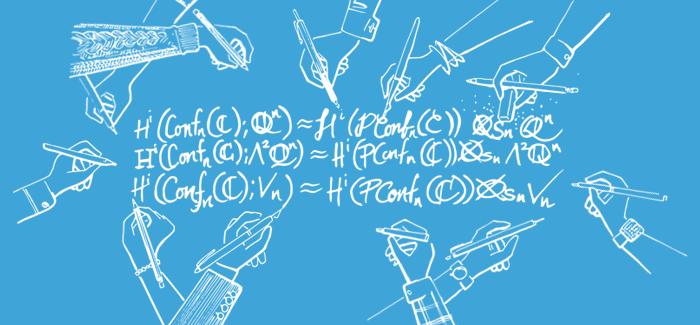
Illustration by Tom Tian, AB’10 
This article originally appeared in the Fall 2014 issue of Inquiry, the biannual publication produced for University of Chicago Physical Sciences Division alumni and friends.
Benson Farb imagines mathematics transformation through collaboration.
Laboratories are a mainstay of experimental science. Mathematics professor Benson Farb, who studies geometry and topology, argues that mathematicians should have that explorative and collaborative experience as well, in a common physical and intellectual space: a math laboratory.
This type of collaboration exists in a few institutes, like the Mathematical Sciences Research Institute in Berkeley, California, but has not yet been incorporated by universities. In an educational environment, says Farb, math laboratories could change the way math is researched and taught, which in turn would have a ripple effect. “Every other science is infused with math, uses the language of math. The underlying way we understand the world is via mathematics.”
Historically, mathematics was a solitary effort, but “in the last 30 years, math has become much more collaborative, has undergone a paradigm shift,” says Farb. The culture of math research has always included sharing ideas, but with advances in communication—email, document-sharing platforms, social media—researchers find it easier to connect with colleagues, continuing to work together after a conference, for instance.
Farb thinks collaboration could be facilitated even more. “Wouldn’t it be great to have something like a lab, where a bunch of professors, perhaps a physicist, a mathematician, or a biologist have offices in one location with space for graduates, undergraduates, and postdocs and a central place where everyone could meet and hang out?” They would benefit from “open doors,” physically and psychologically.
Ideally, professors would have a second office in a math lab, where they would devote their energies to a central project. Faculty, students, and postdoctoral fellows would contribute, and the department would also invite experts from outside the University to visit the lab, join the group, present research, and interact with students. They might stay a week, a month, or several months, as a mathematician or scientist-in-residence.
Mathematics department chair Shmuel Weinberger shares Farb’s enthusiasm. While there’s much work to be done, like securing space and funding for researchers-in-residence, a few possible University math laboratories have been considered. Weinberger has proposed one focusing on geometry, complexity, and theoretical pure science. Professor Amie Wilkinson suggested a project on one of her specialties, dynamical systems, and Panagiotis Souganidis, Charles H. Swift Distinguished Service Professor, could lead a lab based on analysis and applied math.
You can’t just throw scientists and mathematicians together and expect a spark, though. Math labs “must start from the bottom up,” says Farb. Collaboration must already be in the works, around which a math lab can be built to throw fuel on that existing flame. Four years ago, Farb was working with then-doctoral student Thomas Church, SM’07, PhD’11, and University of Wisconsin professor Jordan Ellenberg when they discovered a pattern—a phenomenon they called representation stability. They found it all over the field of mathematics, says Farb. It would have been a perfect project for a math lab.
Such labs, Farb believes, will speed up problem solving and promote interdisciplinary research. Math labs will also bring students, particularly undergraduates, into the world of investigation. In the classroom, students “are not seeing me fail,” says Farb. “They’re seeing me present material that I already understand.” In math labs, they will see research being performed. They will see how mathematicians’ brains work, the methods they use to advance the field.
And the students will help the researchers. By asking questions, they help Farb pinpoint material he thinks he understands but actually doesn’t. “Chicago is the absolute perfect place for this to happen, because the students have infinite energy,” Farb says. “They would eat this up.” The researchers will bring the vision, and the students will provide the energy to sustain a math laboratory.
The department must still determine metrics of success, perhaps number of papers published or students recruited, but “we’re coming from a position of strength,” says Farb. “Our department is the best it’s been since the famous Stone Age in the early ’50s,” when chair Marshall Stone filled the department with the best mathematicians in every field. “Now is the time to be bold.”
For more information about math labs, please contact Brian Yocum at 773.702.3751 or byocum@uchicago.edu.
